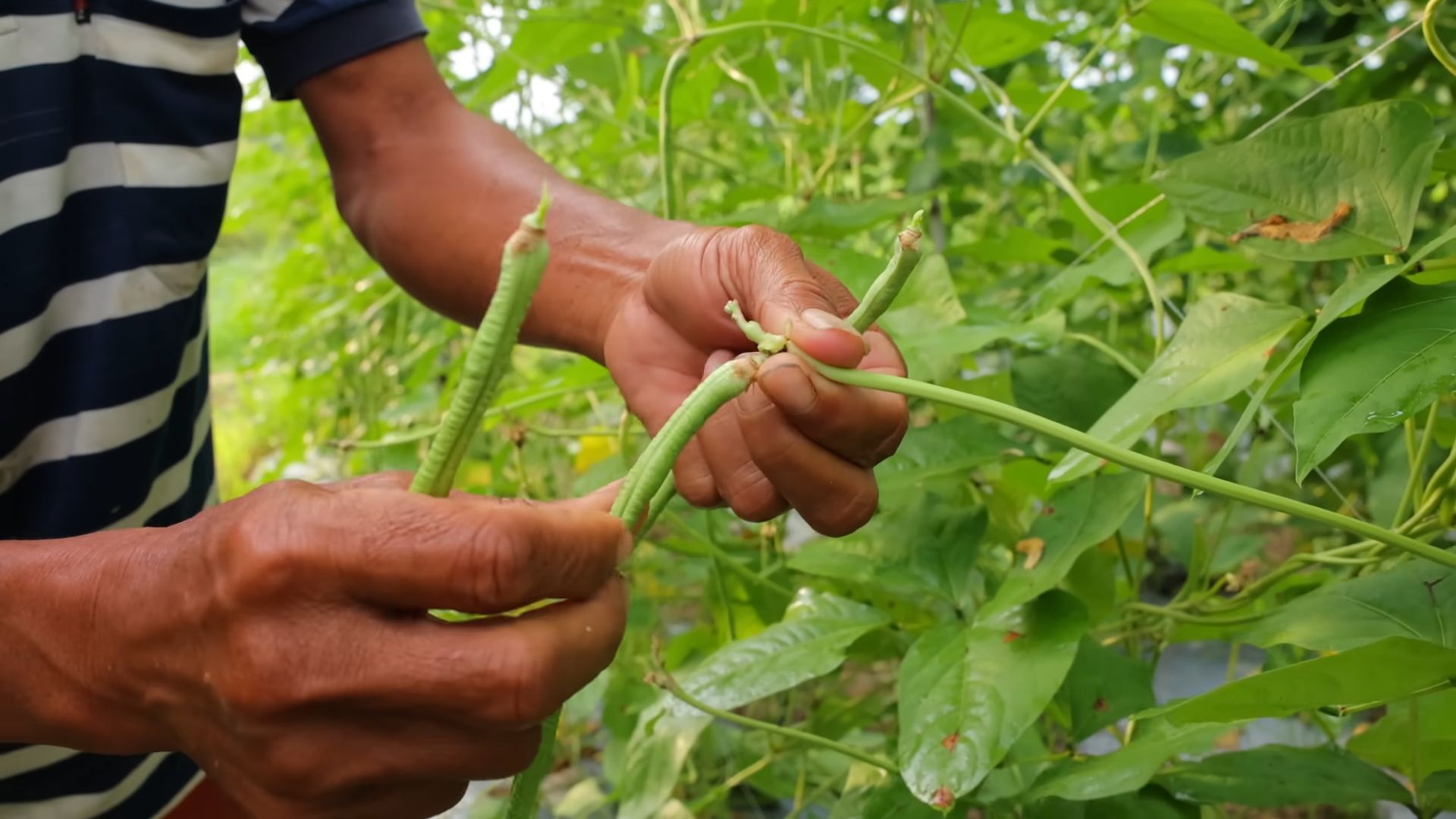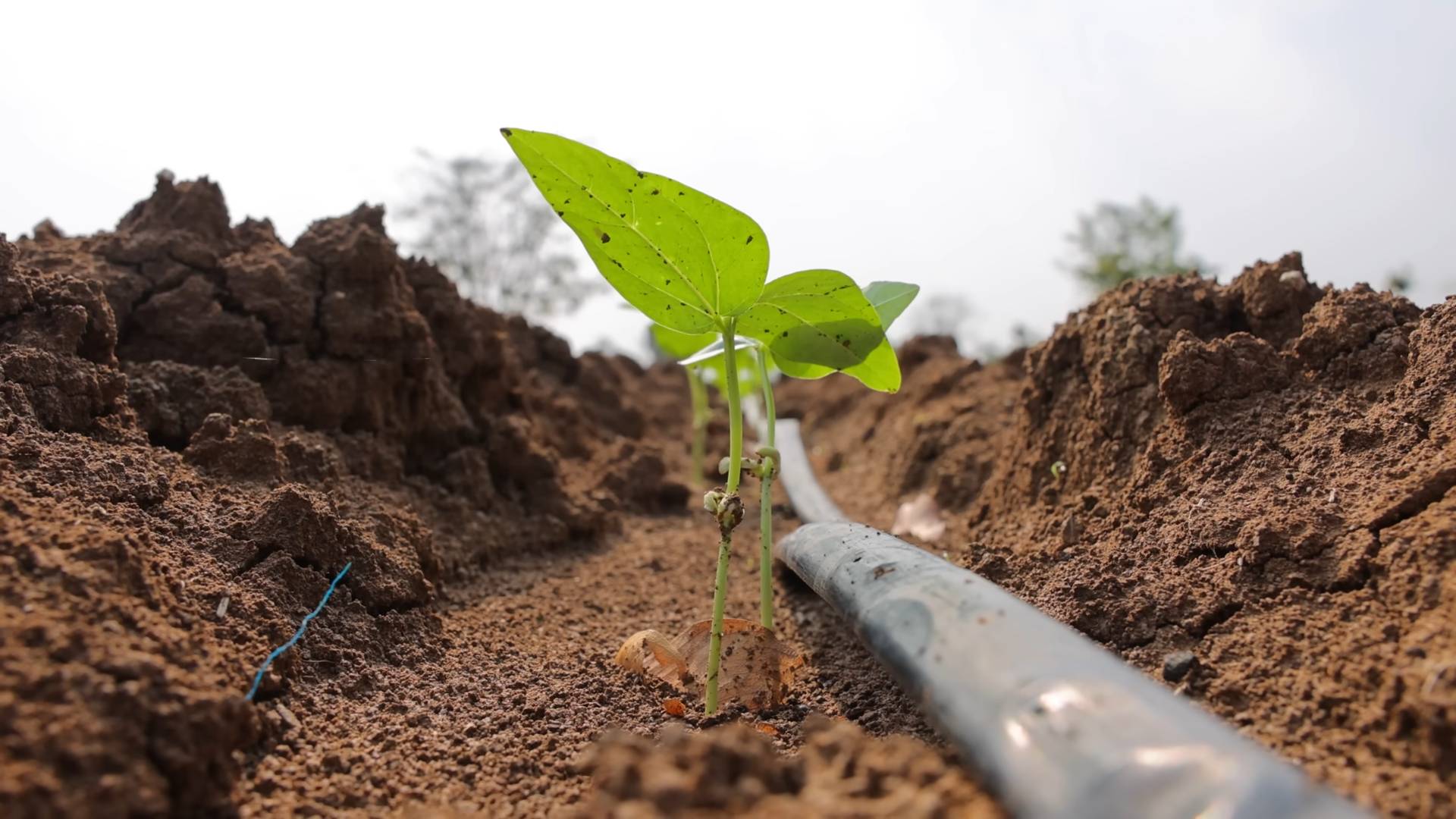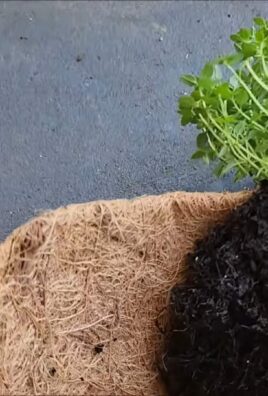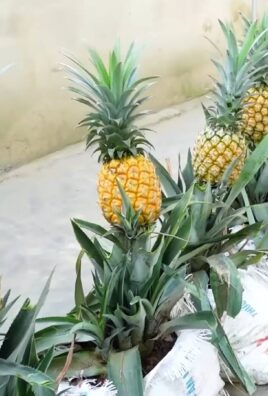Growing String Beans doesn’t have to be a daunting task! Imagine stepping outside your back door and harvesting a basketful of crisp, tender string beans, fresh from your own garden. Sounds idyllic, right? Well, it’s totally achievable, even if you’re a beginner gardener like I once was!
For centuries, string beans have been a staple in diets around the world. From ancient civilizations cultivating them for sustenance to modern-day chefs incorporating them into gourmet dishes, these versatile veggies have stood the test of time. But let’s be honest, buying them at the grocery store just doesn’t compare to the vibrant flavor and satisfying crunch of homegrown beans.
That’s where these DIY tricks and hacks come in. Maybe you’re struggling with poor yields, pest infestations, or simply don’t know where to start. I’ve been there! This article is packed with simple, effective solutions to help you overcome common challenges and unlock the secrets to a bountiful harvest. Growing String Beans successfully is within your reach, and I’m here to guide you every step of the way. Get ready to transform your garden and enjoy the delicious rewards of your labor!

DIY: From Seed to Supper – Growing String Beans Like a Pro!
Okay, so you want to grow string beans? Awesome! They’re super rewarding, relatively easy to care for, and nothing beats the taste of fresh, homegrown beans. I’m going to walk you through everything you need to know, from picking the right variety to harvesting a bumper crop. Let’s get started!
Choosing Your Bean Variety
First things first, you need to decide what kind of string bean you want to grow. There are two main types: bush beans and pole beans.
* Bush Beans: These are compact and don’t need any support. They’re great for smaller gardens or containers. They produce a lot of beans at once, making them perfect for canning or freezing.
* Pole Beans: These are climbers and need a trellis or other support to grow on. They produce beans over a longer period, so you’ll have a steady supply throughout the season.
Within these two types, there are tons of different varieties to choose from! Here are a few popular ones:
* Bush Bean Varieties:
* Blue Lake Bush: A classic, reliable variety with excellent flavor.
* Provider: Early-maturing and disease-resistant.
* Contender: Another early variety, known for its high yields.
* Pole Bean Varieties:
* Kentucky Wonder: A popular heirloom variety with a rich flavor.
* Scarlet Runner: Beautiful red flowers and delicious beans (plus, the flowers attract hummingbirds!).
* Fortex: Long, slender beans with a delicate flavor.
I personally love Kentucky Wonder pole beans because they taste amazing and the vines look so pretty climbing up my trellis. But honestly, you can’t go wrong with any of these!
Preparing Your Garden Bed
String beans need at least 6-8 hours of sunlight per day, so choose a sunny spot in your garden. They also prefer well-drained soil that’s rich in organic matter.
Here’s how to prepare your garden bed:
1. Clear the Area: Remove any weeds, rocks, or debris from the area where you’ll be planting your beans.
2. Amend the Soil: String beans like soil that is slightly acidic to neutral (pH 6.0 to 7.0). You can test your soil pH with a home test kit. If your soil is too acidic, add some lime. If it’s too alkaline, add some sulfur.
3. Add Compost: Mix in a generous amount of compost or other organic matter to improve drainage and fertility. I usually add about 2-3 inches of compost to my garden beds.
4. Loosen the Soil: Use a garden fork or tiller to loosen the soil to a depth of about 12 inches. This will help the bean roots grow easily.
5. Smooth the Surface: Rake the surface of the soil to create a smooth, even planting bed.
Planting Your String Beans
String beans are warm-weather crops, so you’ll want to wait until the danger of frost has passed before planting them. The soil temperature should be at least 60°F (16°C).
Here’s how to plant your string beans:
1. Direct Sowing: String beans are best direct-sown, meaning you plant the seeds directly into the garden. They don’t transplant well.
2. Spacing:
* Bush Beans: Plant seeds 1-2 inches deep and 2-4 inches apart in rows that are 18-24 inches apart.
* Pole Beans: Plant seeds 1-2 inches deep and 4-6 inches apart at the base of your trellis or support.
3. Watering: Water the soil thoroughly after planting. Keep the soil moist but not soggy until the seeds germinate.
4. Germination: String bean seeds usually germinate in 5-10 days, depending on the soil temperature.
Building a Trellis for Pole Beans
If you’re growing pole beans, you’ll need to provide them with a trellis or other support to climb on. There are lots of different ways to build a trellis, from simple to elaborate. Here are a few ideas:
* Bamboo Trellis: Tie bamboo poles together to create a teepee or A-frame trellis.
* Netting Trellis: Stretch netting between two posts or supports.
* Wire Trellis: Use wire or metal fencing to create a sturdy trellis.
* Existing Structures: You can also train pole beans to climb on fences, arbors, or even trees (just make sure they don’t shade out other plants).
I personally like to use a simple bamboo teepee trellis. It’s easy to build and looks nice in the garden.
Here’s how I build my bamboo teepee trellis:
1. Gather Materials: You’ll need 4-5 bamboo poles (about 6-8 feet long), twine, and scissors.
2. Arrange the Poles: Arrange the bamboo poles in a circle, leaning them towards the center.
3. Tie the Poles Together: Tie the tops of the poles together with twine, creating a teepee shape.
4. Secure the Base: Push the base of each pole into the ground to secure the trellis.
5. Add Horizontal Supports (Optional): For extra support, you can tie horizontal bamboo poles or twine between the vertical poles.
Caring for Your String Beans
Once your string beans have germinated, it’s important to provide them with proper care to ensure a healthy and productive crop.
* Watering: Water your string beans regularly, especially during dry weather. Aim to keep the soil consistently moist but not soggy. Water deeply at the base of the plants to avoid wetting the foliage, which can lead to disease.
* Fertilizing: String beans don’t need a lot of fertilizer, but you can give them a boost with a side dressing of compost or a balanced fertilizer a few weeks after they emerge. Avoid using fertilizers that are high in nitrogen, as this can promote leafy growth at the expense of bean production.
* Weeding: Keep your garden bed free of weeds, which can compete with your string beans for nutrients and water. Hand-pull weeds regularly or use a hoe to cultivate the soil.
* Pest Control: String beans can be susceptible to a few pests, such as aphids, bean beetles, and spider mites. Inspect your plants regularly for signs of infestation. You can usually control these pests with organic methods, such as insecticidal soap, neem oil, or hand-picking.
* Supporting Pole Beans: As your pole beans grow, gently guide the vines onto the trellis. They’ll usually start climbing on their own, but you may need to help them get started.
Harvesting Your String Beans
The best part! String beans are usually ready to harvest about 50-60 days after planting.
Here’s how to harvest your string beans:
1. Check for Maturity: The beans should be firm, crisp, and snap easily when bent. They should also be the right size for the variety you’re growing.
2. Harvest Regularly: Harvest your string beans regularly, every few days, to encourage continued production. Overripe beans can become tough and stringy.
3. Pick Carefully: Use scissors or pruning shears to cut the beans from the plant, leaving a short stem attached. Be careful not to damage the plant.
4. Enjoy Your Harvest: String beans are delicious fresh, steamed, sautéed, or added to soups and stews. You can also preserve them by canning, freezing, or drying.
Troubleshooting Common Problems
Even with the best care, you might encounter a few problems when growing string beans. Here are some common issues and how to deal with them:
* Poor Germination: If your string bean seeds aren’t germinating, it could be due to cold soil, poor soil drainage, or old seeds. Make sure the soil temperature is at least 60°F (16°C) before planting. Improve soil drainage by adding compost or other organic matter. Use fresh seeds for best results.
* Yellowing Leaves: Yellowing leaves can be a sign of nutrient deficiency, overwatering, or disease. Check the soil pH and nutrient levels. Make sure the soil is well-drained. Treat any diseases with appropriate fungicides.
* Pest Infestations: As mentioned earlier, string beans can be susceptible to pests like aphids, bean beetles, and spider mites. Inspect your plants regularly and treat any infestations with organic methods.
* Disease: String beans can be affected by diseases such as bean rust, anthracnose, and powdery mildew. Choose disease-resistant varieties. Provide good air circulation around the plants. Avoid wetting the foliage when watering. Treat any diseases with appropriate fungicides.
* Lack of Bean Production: If

Conclusion
So, there you have it! Growing string beans doesn’t have to be a daunting task reserved for seasoned gardeners. With this simple DIY trick – the trellis system we discussed – you can unlock a bountiful harvest of crisp, delicious string beans right in your own backyard, balcony, or even a sunny windowsill.
Why is this DIY approach a must-try? Because it’s efficient, space-saving, and dramatically improves the yield of your string bean plants. By providing vertical support, you’re not only maximizing your growing area but also promoting better air circulation, which helps prevent fungal diseases that can plague sprawling bean plants. Plus, harvesting becomes a breeze when the beans are hanging conveniently at eye level!
But the beauty of this DIY project lies in its adaptability. Feel free to experiment with variations to suit your specific needs and preferences. For instance, if you’re short on space, consider using a smaller, A-frame trellis. If you’re growing bush beans instead of pole beans, you might only need a simple support structure to prevent them from sprawling too much. You can also get creative with the materials you use. Bamboo stakes, repurposed branches, or even sturdy tomato cages can all be adapted to create effective string bean trellises.
Consider companion planting to further enhance your string bean garden. Marigolds can deter pests, while nasturtiums attract beneficial insects. Planting beans near carrots or cucumbers can also be mutually beneficial.
Don’t be afraid to get your hands dirty and embrace the joy of growing your own food. This DIY string bean trellis is a fantastic way to connect with nature, learn new skills, and enjoy the satisfaction of harvesting fresh, homegrown produce.
We wholeheartedly encourage you to try this DIY trick for growing string beans. It’s a rewarding experience that will transform your gardening efforts. And most importantly, we want to hear about your success! Share your photos, tips, and experiences in the comments below. Let’s build a community of string bean enthusiasts and learn from each other’s gardening journeys. Happy growing!
Frequently Asked Questions (FAQ)
What are the best varieties of string beans to grow using this DIY trellis method?
The best varieties for trellis growing are pole beans, as they naturally climb. Some popular and productive pole bean varieties include Kentucky Wonder, Blue Lake Pole, and Scarlet Runner beans. These varieties produce long, abundant harvests and are well-suited for vertical growing. If you’re looking for something a little different, consider trying yardlong beans, which can grow incredibly long and are a fun addition to any garden. Bush beans, while not climbers, can still benefit from a small support structure to keep them upright and prevent them from sprawling too much.
How do I build a simple trellis for my string beans?
Building a trellis doesn’t have to be complicated. A simple A-frame trellis can be constructed using bamboo stakes or wooden poles. Simply arrange two stakes in an A-shape, securing them at the top with twine or wire. Repeat this process to create multiple A-frames, spacing them a few feet apart. Then, connect the A-frames with a horizontal pole or wire to provide additional support. Another option is to use a cattle panel or wire mesh attached to sturdy posts. The key is to provide a strong and stable structure that the string beans can easily climb.
How often should I water my string beans growing on a trellis?
String beans need consistent moisture, especially during flowering and pod development. Water deeply and regularly, aiming for about 1 inch of water per week. Check the soil moisture regularly and water when the top inch feels dry to the touch. Avoid overwatering, as this can lead to root rot. Using a soaker hose or drip irrigation system can help deliver water directly to the roots and minimize water loss through evaporation. Mulching around the base of the plants can also help retain moisture in the soil.
What kind of soil is best for growing string beans?
String beans thrive in well-drained, fertile soil with a pH between 6.0 and 7.0. Amend your soil with compost or other organic matter to improve drainage and fertility. Avoid heavy clay soils, as they can become waterlogged and inhibit root growth. Before planting, consider conducting a soil test to determine any nutrient deficiencies and amend accordingly. String beans are relatively light feeders, but they benefit from a balanced fertilizer applied at planting time.
How do I protect my string beans from pests and diseases?
Regularly inspect your string bean plants for signs of pests and diseases. Common pests include aphids, bean beetles, and spider mites. Control pests by handpicking them off the plants, using insecticidal soap, or introducing beneficial insects like ladybugs. To prevent fungal diseases, ensure good air circulation around the plants by spacing them properly and pruning away any overcrowded foliage. Avoid overhead watering, as this can create a humid environment that promotes fungal growth. Consider using a copper fungicide as a preventative measure.
When is the best time to harvest my string beans?
Harvest string beans when the pods are firm, crisp, and about the size of a pencil. Avoid letting the pods become too large and tough, as this will affect their flavor and texture. Harvest regularly to encourage continued production. Snap the beans off the plant carefully to avoid damaging the vines. The best time to harvest is in the morning, when the beans are at their peak freshness.
Can I grow string beans in containers using this trellis method?
Yes, you can absolutely grow string beans in containers using a trellis. Choose a large container that is at least 12 inches deep and wide to accommodate the root system. Use a well-draining potting mix and provide adequate support for the vines. Water regularly and fertilize as needed. Container-grown string beans may require more frequent watering and fertilization than those grown in the ground. Place the container in a sunny location that receives at least 6 hours of sunlight per day.
What are some common problems when growing string beans and how can I fix them?
Some common problems include poor germination, yellowing leaves, and lack of pod production. Poor germination can be caused by cold soil temperatures or planting seeds too deep. Yellowing leaves can indicate nutrient deficiencies or overwatering. Lack of pod production can be caused by insufficient sunlight, poor pollination, or stress from pests or diseases. Address these problems by ensuring proper soil conditions, providing adequate sunlight and water, and controlling pests and diseases.
How can I save seeds from my string beans for next year?
Saving seeds from your string beans is a great way to preserve your favorite varieties and save money. Allow some of the pods to mature fully on the plant, until they are dry and brown. Remove the seeds from the pods and spread them out on a tray to dry completely. Store the dried seeds in an airtight container in a cool, dark, and dry place. Label the container with the variety and date. Seeds can remain viable for several years if stored properly.
What are some creative ways to use my homegrown string beans?
Beyond the classic steamed or sautéed string beans, there are countless ways to enjoy your homegrown harvest. Try pickling them for a tangy snack, adding them to stir-fries or casseroles, or using them in salads. You can also blanch and freeze them for later use. Get creative in the kitchen and experiment with different recipes and flavor combinations. Fresh, homegrown string beans are a versatile and delicious addition to any meal.




Leave a Comment